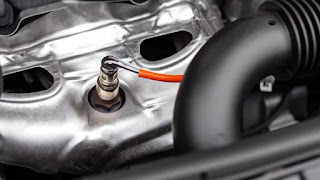When Should the Oxygen Sensor Be Replaced?
Modern car engine control systems rely on input from several sensors to regulate the engine’s performance as well as its emissions and other vital functions. When these sensors fail to provide accurate information, the driver may experience increased fuel consumption, driveability problems, emission failures and other problems.
One of the most important sensors in modern cars is the oxygen sensor. Also known as the O2 sensor because O2 is the chemical formula for oxygen, the oxygen sensor monitors how much unburned oxygen is present in the exhaust as exhaust exits the engine. By monitoring oxygen levels, the sensor provides a means of measuring fuel mixture. The O2 sensor lets the computer know if the fuel mix is burning rich (not enough oxygen) or lean (too much oxygen). Knowing the ratio of fuel to air allows your vehicle’s engine to make any necessary changes to ensure that your car runs like it should.
O2 sensors are mandatory on all cars manufactured since 1981. Due to the ODB-II regulations that apply to cars manufactured in 1996 and after, many newer cars have multiple O2 sensors. In fact, some cars have as many as four oxygen sensors. Cars made in 1996 and after are required to have a second oxygen sensor that is located below the catalytic converter. This O2 sensor monitors the operating efficiency of the catalytic converter.
If the sensor after the catalytic converter shows minimal changes from the reading on the first oxygen sensor, it is a sign that the catalytic converter is not working properly. Modern vehicles with V-6 or V-8 engines could have as many as four O2 sensors — one located in each cylinder bank and one after each catalytic converter. If either the oxygen sensor in the cylinder block or the one for the catalytic converter fails, your vehicle could experience serious engine problems.
Because oxygen sensors play a vital role in your engine’s performance and emissions control, you may wonder when to think about replacement.
When Should You Replace Your O2 Sensor?
Oxygen sensors are not among the maintenance items that need to be replaced regularly, such as oil and air filters, so they typically are replaced only when they fail.
Oxygen sensors are a critical component of the fuel and emissions systems because they monitor the amount of oxygen in the exhaust and transmit that information to the engine computer, which adjusts the air-to-fuel ratio accordingly. If an oxygen sensor fails, the engine computer won’t be able to correctly set the air-fuel ratio, which could result in lower fuel economy, higher emissions and damage to other components, such as an overheated catalytic converter.
No vehicle that we’re aware of has a warning light that signals when an oxygen sensor has failed, so you have to rely on other vital signs to alert you when you have a bad oxygen sensor that you will need to replace, such as the check-engine light on the dashboard illuminating and increased fuel usage.
Signs You Need a New O2 Sensor
An illuminated check-engine light could be a sign of a more serious issue, such as with the catalytic converter, or something as minor as a loose gas cap, so further investigation is always required. It could, however, indicate that there is a problem with your O2 sensor or even another part of your exhaust or emissions system. Any repair shop should be able to read what triggered your check-engine light, and a mechanic or auto parts store may perform this service for free.
Other signs that you need a new oxygen sensor include a rough idle, misfiring spark plugs, lack of power, stalling or a significant increase in fuel consumption. Those symptoms could also be indications of other problems, but the EPA says that replacing a bad oxygen sensor can improve fuel economy by as much as 40 percent, so clearly that is one place to look if your vehicle develops a greater thirst for gas. If your vehicle fails an emissions test, a faulty O2 sensor may be to blame for this as well.
A new oxygen sensor can cost from less than $100 on some models to $300 or more on others, but that doesn’t include labor, which can vary widely by vehicle because of where the sensors are located. As a result, the full cost of oxygen sensor replacement may vary greatly depending on the type of vehicle you drive.



0 Comments